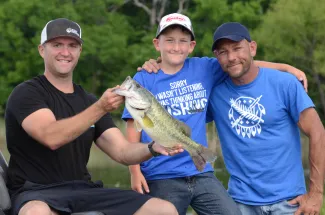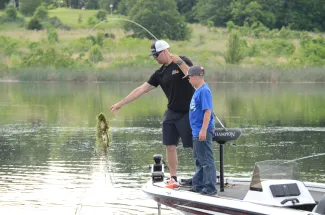
Bass rank at the top of the list for most sought after species of fish in Oklahoma. This is likely due to their aggressiveness to hit both live and artificial baits, but also due to the amazing lakes, creeks, and countless ponds throughout the state that offer bass fishing opportunities. One of the more common pond related questions that fisheries biologists are asked is how to fix a stunted population.
What is a stunted bass population?
Let’s start with the basics – a stunted population consists of an overabundance of fish growing at a slow rate with most, if not all, bass between 7 and 12 inches in length. They also tend to have skinny or sunken bellies, and their heads appear larger than would be expected of a bass of that size. The cause of this is a lack of food availability due to an imbalance in the system.
There are several reasons, or a combination of reasons, that a population could be out of balance. In my experience, the most common issue is excessive aquatic vegetation. These fish are top end predators that need to ambush or chase their prey to feed. Too much vegetation interrupts their ability to effectively feed. In addition to impacting a bass’ ability to forage on smaller prey, it provides ample amounts of nursery habitat for small fish, including juvenile bass, to survive. This results in higher than normal survival and causes population crowding and competition for food.
Other potential causes of stunting are water level fluctuations or overharvest. Drastic swings in water levels caused by flooding and drought cycles could lead to stunting issues. Successful spawning during above average water years could lead to crowding and population imbalances in successive drought years when the pond is low and fish are crowded into less habitat. Likewise, overharvest of larger bass in a population could lead to a stockpiling of smaller fish all competing for similar resources.

How do you fix a stunted bass population?
Regardless of how a stunted population began, the solution is achieving a balance between predator and prey. Sounds easy, right? Maybe, but stunted bass populations do not occur overnight and neither will the solutions. Let’s discuss some of those solutions.
I’ve been asked many times, “can I just stock more minnows to feed my bass and get them growing better?” Unfortunately, this will likely only have short-term benefits. Once all the minnows are consumed, the issues that caused the imbalance will remain. Not to mention, purchasing minnows can get expensive. It would be the equivalent of feeding a herd of cattle year-round with hay, because there was no grass to eat.
To expand upon this cattle analogy, the best solution to fix a stunted bass population is to “thin the herd.” The removal of predators will reduce competition for limited prey resources and allow the remaining fish to start growing to larger sizes. There are general guidelines for the amounts to remove from a pond, and it can range from 10 – 15 pounds of bass per acre each year until the problem is resolved. Two key points to this recommendation, however, is to know the surface area of the pond and to understand this solution may take years before you see improvements.
If you suspect excessive vegetation may be a cause of the stunting problem, dealing with this issue will greatly improve your chances for success. But know that not all aquatic vegetation is the same and neither are the solutions. Positive identification of the types of vegetation is the key to developing a control strategy. Contacting an ODWC fisheries office or fish hatchery in your area is a valuable first step in developing a vegetation control plan.
Are there any benefits to having a stunted bass population?
If your goal is to have a quality pond where you can regularly catch 3 – 5 pound bass, then fixing a stunted bass problem should be a top priority. However, if your goal is to have a pond where you can catch lots of fish, and you are less concerned about size, then a stunted bass pond may be right for you. Young anglers, whether they are your kids, grandkids, friends, or neighbors, all love the fast paced action that an overpopulated, stunted bass pond can provide.